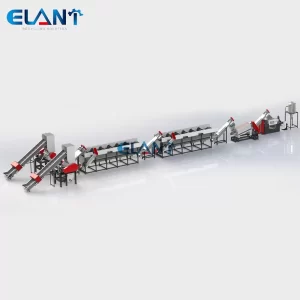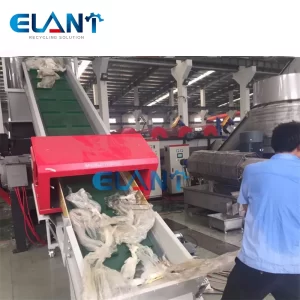In the era of environmental awareness and sustainability, the need for efficient plastic recycling has become increasingly important. One of the key elements in plastic recycling is the plastic washing line—a comprehensive system designed to clean and prepare used plastic materials for further processing. This article will delve into the details of what a plastic washing line is, its components, and its significance in the recycling industry.
Understanding the Plastic Washing Line
A plastic washing line is a specialized system that involves multiple stages to clean contaminated plastic waste, such as bottles, bags, and films. The washing process removes dirt, adhesives, labels, and other impurities from the plastic materials. After cleaning, the plastic is ready for further processing, such as shredding, pelletizing, or even direct reuse in manufacturing new products.
Plastic washing lines are used by recycling companies, manufacturers, and even municipal waste management facilities as part of a larger recycling ecosystem. By efficiently cleaning plastic waste, they play a crucial role in turning discarded plastic into usable material, reducing the need for virgin plastics and helping to combat environmental pollution.

Components of a Plastic Washing Line
A plastic washing line is composed of various components that work together to ensure efficient and thorough cleaning of plastic waste. Each component plays a specific role in ensuring that the plastic is properly cleaned and prepared for the next stage of processing.
1. Conveyor System
The conveyor system serves as the first step in the washing line. It transports the raw plastic waste from collection points to the washing machinery. This system can be equipped with sorting mechanisms to remove non-plastic materials, such as metals, paper, or glass, ensuring that only plastic waste enters the washing process.
2. Shredder or Granulator
Once the plastic waste has been sorted, it passes through a shredder or granulator. These machines cut the plastic waste into smaller pieces, typically referred to as flakes. This shredding process increases the surface area of the plastic, making it easier to clean during the subsequent washing stages.
3. Pre-Washer
The pre-washer is responsible for an initial rinse of the plastic flakes. This stage removes large debris, such as dirt and dust, that may have accumulated on the surface of the plastic. The pre-washing process can include the use of water, detergents, or other cleaning agents to enhance the effectiveness of this stage.
4. Friction Washer
Following the pre-washing stage, the plastic flakes enter the friction washer. This high-speed washing machine uses mechanical agitation to scrub the plastic flakes, removing adhesives, labels, and other contaminants that may still be present. The friction generated during this process ensures that even the most stubborn impurities are dislodged.
5. Sink-Float Separation Tank
In the sink-float separation tank, plastic flakes are separated based on their density. Plastics like PET (polyethylene terephthalate) will sink to the bottom of the tank, while lighter plastics such as PE (polyethylene) and PP (polypropylene) will float on the surface. This separation is crucial in sorting different types of plastics for further processing.
6. Hot Washer
The hot washer uses heated water combined with detergent or caustic solutions to remove oil, grease, and other contaminants that may not be eliminated during the friction washing stage. Hot washing is particularly effective for plastics that have been exposed to food or beverage residues, ensuring they are cleaned to a high standard.
7. Rinse Tank
After hot washing, the plastic flakes are rinsed in a rinse tank to remove any remaining detergent or caustic solution. This step ensures that the plastic is free from any chemicals that could interfere with further processing or degrade the quality of the recycled material.
8. Dewatering Machine
Once the plastic has been thoroughly cleaned and rinsed, it passes through a dewatering machine. This machine uses centrifugal force to remove excess water from the plastic flakes, reducing the moisture content to a manageable level. Proper dewatering is important because high moisture levels can negatively affect the quality of the final recycled product.
9. Drying System
The drying system further reduces the moisture content of the plastic flakes. Hot air drying or infrared drying systems are commonly used to ensure the flakes are completely dry before moving to the final stages of processing.
10. Air Classifier
In some plastic washing lines, an air classifier is used as a final cleaning stage. This machine uses airflow to separate light contaminants, such as dust or paper, from the heavier plastic flakes. The air classifier helps ensure that the final product is free from any remaining impurities.
11. Storage Silos
After the cleaning and drying processes, the plastic flakes are stored in storage silos before being transported to the next stage of processing. These silos allow for the temporary storage of large quantities of cleaned plastic flakes, ensuring a steady supply of material for recycling or further processing.

The Importance of a Plastic Washing Line
A plastic washing line is not just a series of machines but a crucial step in the broader process of plastic recycling. The cleanliness of the plastic materials directly impacts the quality of the recycled products. High levels of contamination can lead to defects in recycled plastic products, reducing their market value and limiting their applications.
Environmental Benefits
By effectively cleaning plastic waste, washing lines help reduce the volume of plastic waste sent to landfills or incinerated, which significantly lowers greenhouse gas emissions and environmental pollution. Recycling plastic also conserves resources, as less virgin plastic needs to be produced, saving energy and reducing the consumption of fossil fuels.
Economic Value
Plastic washing lines add economic value by turning what was once waste into a resource. Clean plastic flakes can be sold to manufacturers for use in producing new products, creating a circular economy that benefits both businesses and the environment. Furthermore, the ability to recycle plastics locally through washing lines reduces the cost and environmental impact of transporting plastic waste to distant recycling facilities.
Different Types of Plastic Washing Lines
Depending on the type of plastic waste and the level of contamination, different types of plastic washing lines may be used. These include lines for post-consumer PET bottles, film recycling, and even industrial plastic waste.
PET Bottle Washing Line
The PET bottle washing line is designed specifically for recycling post-consumer PET bottles. These bottles are collected, sorted, and processed into clean PET flakes, which can be used to produce new bottles, fibers, or other plastic products.
Plastic Film Washing Line
The plastic film washing line is specialized for handling thin plastic films, such as agricultural films, packaging materials, and plastic bags. Since plastic films can easily become contaminated with dirt and other debris, this type of washing line includes advanced cleaning stages to ensure the film is thoroughly cleaned.
Industrial Plastic Waste Washing Line
Industrial plastic waste washing lines are used to process plastic waste generated by manufacturing or industrial processes. These lines can handle a variety of plastics, including large, rigid plastics that are more difficult to process than household waste.
Conclusion
A plastic washing line is a vital component of the plastic recycling process, ensuring that plastic waste is thoroughly cleaned and prepared for reuse. By using specialized machinery and techniques, washing lines can handle a variety of plastic materials, from post-consumer bottles to industrial plastic waste. The environmental and economic benefits of plastic washing lines are undeniable, as they contribute to a more sustainable future by turning waste into valuable resources.
